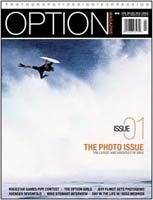The Bastard Child—Bodyboarding Gets Short-Changed… Again (1/03)
Here is the original text from an article written for Mike Latronic's Board Stories magazine. It was written in just two days and I unfortunately did not have time to do heavy research and verify all my facts. The "Errata" section in the end was my hope to correct the misrepresentation in what went down during the contest scheduling fiasco. Introduction Bodyboarding has always held second-class status amongst the waveriding community. But this past November was especially bad when the sport was dealt a double-whammy blow. The self proclaimed “Bible of the Sport,” BodyBoarding magazine, folded up shop and stopped publishing. Simultaneously, the City and County of Honolulu released their North Shore surf contest event calendar and (initially) failed to include both bodyboarding events. Bodyboarders are on the cutting edge of waveriding, and yet it seems the industry is about to implode on itself. What gives? The Prejudice
Waveriders in general have this belief system that if they pay their dues—through lots of water time—they feel more entitled to waves (not saying that this is right or wrong—only that it is). Now along come these clueless beginners who seem to clog the lineup with bodyboards. How do the regulars feel? In short, they’re pissed off! And to some extent, they do have a valid beef. Longtime waveriders know that there are many unwritten rules of engagement, many of them lineup-specific. Newbies invariably don’t know even the basics like not dropping in on others or to stay out of the way. There’s a huge potential for conflict right there. Of course, not all bodyboarders are incompetent. That’s where the frustration amongst the bodyboarding community lies—that they are all prejudged by the actions of others. Bodyboarders ride mostly prone so standup surfers literally (and many times figuratively) look down on them. We’ve heard it all, like “stand up like a man” or “it don’t count unless you are standing up.” Bashed on all the time. (Although, it really isn’t so bad in Hawaii compared to elsewhere.) And yet bodyboarders are doing some of the most progressive maneuvers on waves, launching and gyrating with radical aplomb. Only now are surfers tapping into these types of moves, and only on a hit-and-miss basis. With such a limited resource such as waves, the bad side of human nature oftentimes rears its ugly head. Prejudice sucks, but such is life. The Industry
I don’t think there was ever a single entity orchestrating this new industry (although Morey Bodyboards came real close). However, I do think that in general, the fledgling bodyboarding industry leaders probably tried to emulate the surfing industry in marketing, manufacturing and distribution. Early on, the bodyboarding industry did ride on the coattails a bit on surfing. The big surfing companies, especially the well-established clothing and wetsuit companies, supported bodyboarding, probably seeing it as a viable crossover market. And flourish it did. I heard that in its heyday, bodyboards outsold surfboards something like seven to one. Bodyboarders also bought into the surfer image, nicely supplementing the surf industry. However, with the proliferation of bodyboards to lineups worldwide, there grew a growing resentment. Most of the owners of the surf companies were surfers who either were unconcerned with the bodyboarding industry or got chastised for supporting it. The surfing industry seemed to figure out that bodyboarders were going to buy their apparel or wetsuits whether they advertised in the mag or sponsored bodyboarders or not. So when the surf industry recession hit in the early 90’s, these companies (the American ones, anyway) stopped supporting bodyboarding, never returning. So what happened to the bodyboarders trying make a living on the sport? Well, many bodyboarders have gone into production and sales of bodyboarding-specific products: mostly boards and fins. However, the durability of these items, compared to your typically fragile 6’2” shortboard, makes maintaining continued sales volume very difficult. Some have tried to carve out bodyboarder-only apparel and wetsuits, but they never gained favor among the masses. Since there is so little money in bodyboarding companies, professional riders are finding it difficult, if not impossible to sustain a living as a pro. Until bodyboarders “pay their dues” and get into positions of influence in the large surf companies, they will continue to have difficulty finding sponsorship support. It’s hard when you are unloved. The Magazine
However, as mentioned above, the early 90’s brought a great recession to the surfing industry in general. BodyBoarding magazine lost so much in ad sales that it got compressed into an eight-page spread within Surfing magazine. Eventually, the mag did go back on its own, but the large surfwear and wetsuit companies didn’t follow with ads or sponsorship support. Another major shift occurred when Primedia bought out McMullenargus, the parent company of Surfing and BodyBoarding magazines. It seemed that Primedia was trying to put together a stable of action sports magazines, even though they may have been unfamiliar with these niche markets. Eventually, Primedia realized that BodyBoarding mag was not economically viable anymore, which led to the November announcement that the magazine would fold. It’s real easy to point fingers and lay blame for the demise, but truth be told, much of the problem was from within. The vision of the mag seemed to change from “everyone can ride for fun,” to “this is extreme riding only for the top echelon.” The magazine’s target market apparently narrowed to one demographic—teenage boys. The content reflected that with things like the “Surf Shop Hottie” column and stories such as “How to get a tatt.” The mag’s focus was also diluted with video game and music reviews. In the end, the magazine seemed lost and unfocused. Low subscriptions and few advertisers made it easy for the execs to put it on the chopping block. Again, cest la vie . The Contests For 20 years there has been a bodyboarding contest at Pipeline under various sponsorship umbrellas (Surecraft, Morey Bodyboards, Mike Stewart). However, last winter, there was a large quantity of surf contests held on the North Shore, five at Pipeline alone. Gil Riviere’s Let’s Surf Coalition started a grassroots campaign to try and limit the amount of contests being held. The complaint was not without merit. Contests are not supposed to run more than four full days of competition during a maximum 16-day waiting period. Also, contests are not supposed to be held at the same beach within 10 days of each other. Last winter there was a 40-day stretch where Pipeline was “reserved” in a perpetual waiting period for three consecutive contests. So the City and County of Honolulu, distributors of the permits, was asked at the very least to abide by their own rules. When the City finally released the winter contest schedule in November (over four months later than usual), bodyboarders were appalled to find that both longstanding bodyboarding events were not given permits.
So there will be one full contest day set aside for the GOB World Super Tour (WST) and at least one day for the GOB World Qualifying Tour (WQT), with trials to be held prior to this at a site undetermined. Although it is a reduction in amount of contest days (in the past there were four at Pipeline), it is better than nothing. Unfortunately, because of this scheduling fiasco, Human Shoes, the new intended sponsor of the men’s event, withdrew their support. My understanding is that the event will still be held, with or without a sponsor. The odd-man out is Carol Philips and the World Championship of Women’s Bodyboarding. Her event has been pushed back from mid-February to March 13-28, 2003, when the northwest swells typically get less frequent and less powerful. It has already changed the dynamics of the North Shore, with much of the international women bodyboarding contingent absent from the lineups, choosing to arrive closer to the event’s waiting period. In this case, bodyboarding was the unfortunate victim of the greater problem of too many contests on the North Shore. Still, its just another manifestation of the low stature bodyboarding seems to have in the surfing world. The Future So where is bodyboarding going in 2003 and beyond? Well, some say that maybe it was good that BodyBoarding mag folded. The mag seemed to have lost favor with many of the riders, and was not representative of the sport in general.
Irregardless of what happens to the industry, people will continue to enjoy the ocean through bodyboarding. Maybe going back to our roots of bodyboarding purely to have fun, without all the burden of a big industry steering it, is a good thing. Maybe now the bastard child will start smiling again.
|
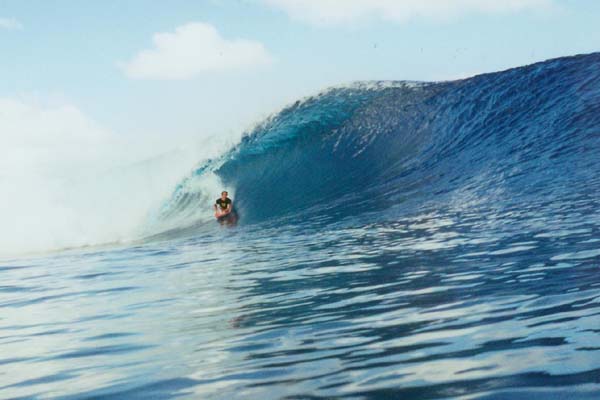
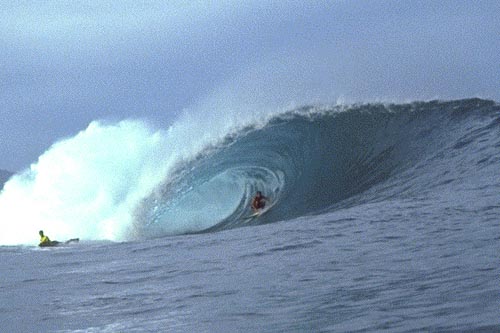 Bodyboarding
has always been bastardized in the waveriding community. The problem
is that it is so easy to learn the bodyboarding basics that anybody
can catch waves on their first go-out. This is contrary to standup
surfing, which requires many sessions just to be marginally competent.
Bodyboarding
has always been bastardized in the waveriding community. The problem
is that it is so easy to learn the bodyboarding basics that anybody
can catch waves on their first go-out. This is contrary to standup
surfing, which requires many sessions just to be marginally competent.
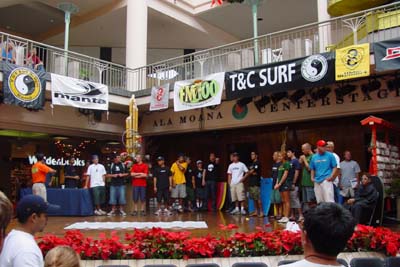 It
was very exciting to see the humble pastime of “boogieboarding” flourish
into a full-fledged industry, complete with professionalism. BodyBoarding
magazine started this opportunity, providing a cohesive glue to give
direction and focus to the fragmented pockets of “boogiemen,” and
creating the avenue for mass sales.
It
was very exciting to see the humble pastime of “boogieboarding” flourish
into a full-fledged industry, complete with professionalism. BodyBoarding
magazine started this opportunity, providing a cohesive glue to give
direction and focus to the fragmented pockets of “boogiemen,” and
creating the avenue for mass sales.
 BodyBoarding
magazine
BodyBoarding
magazine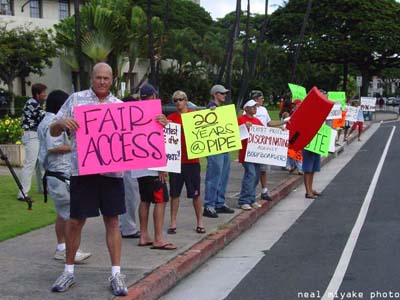 The
bodyboarders protested, rallying at Honolulu Hale (City Hall). After
intense negotiations with City reps and some other event directors,
Bob Thomas of the Global Organization of Bodyboarders (GOB) finalized
a deal to have the men’s bodyboarding contest held between January
30 and February 7, 2003, sharing time with a bodysurfing event.
The
bodyboarders protested, rallying at Honolulu Hale (City Hall). After
intense negotiations with City reps and some other event directors,
Bob Thomas of the Global Organization of Bodyboarders (GOB) finalized
a deal to have the men’s bodyboarding contest held between January
30 and February 7, 2003, sharing time with a bodysurfing event.
